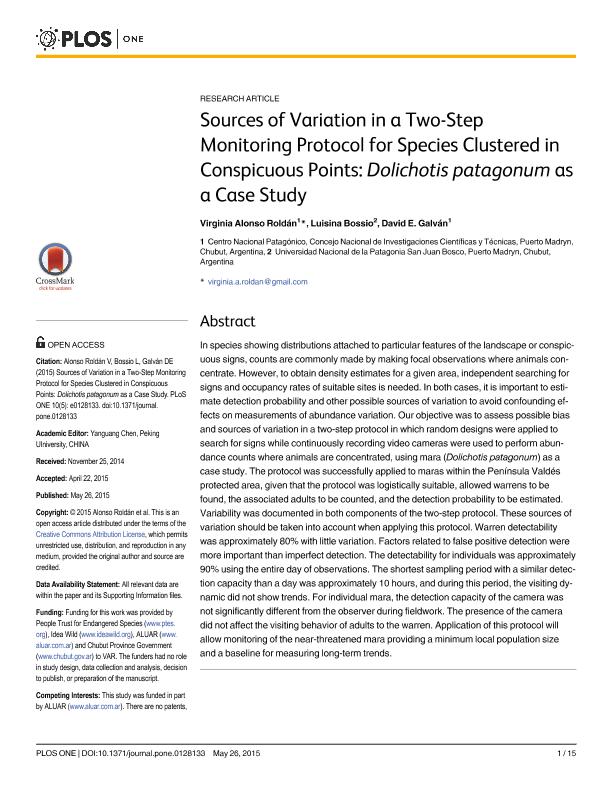Mostrar el registro sencillo del ítem
dc.contributor.author
Alonso Roldán, Virginia

dc.contributor.author
Bossio, Luisina
dc.contributor.author
Galvan, David Edgardo

dc.date.available
2016-05-10T20:40:05Z
dc.date.issued
2015-05
dc.identifier.citation
Alonso Roldán, Virginia; Bossio, Luisina; Galvan, David Edgardo; Sources of variation in a two-step monitoring protocol for species clustered in conspicuous points: Dolichotis patagonum as a case study; Public Library Of Science; Plos One; 10; 5; 5-2015; 1-15
dc.identifier.issn
1932-6203
dc.identifier.uri
http://hdl.handle.net/11336/5614
dc.description.abstract
In species showing distributions attached to particular features of the landscape or conspicuous signs, counts are commonly made by making focal observations where animals concentrate. However, to obtain density estimates for a given area, independent searching for signs and occupancy rates of suitable sites is needed. In both cases, it is important to estimate detection probability and other possible sources of variation to avoid confounding effects on measurements of abundance variation. Our objective was to assess possible bias and sources of variation in a two-step protocol in which random designs were applied to search for signs while continuously recording video cameras were used to perform abundance counts where animals are concentrated, using mara (Dolichotis patagonum) as a case study. The protocol was successfully applied to maras within the Península Valdés protected area, given that the protocol was logistically suitable, allowed warrens to befound, the associated adults to be counted, and the detection probability to be estimated. Variability was documented in both components of the two-step protocol. These sources of variation should be taken into account when applying this protocol. Warren detectability was approximately 80% with little variation. Factors related to false positive detection were more important than imperfect detection. The detectability for individuals was approximately 90% using the entire day of observations. The shortest sampling period with a similar detection capacity than a day was approximately 10 hours, and during this period, the visiting dynamicdid not show trends. For individual mara, the detection capacity of the camera wasnot significantly different from the observer during fieldwork. The presence of the camera did not affect the visiting behavior of adults to the warren. Application of this protocol will allow monitoring of the near-threatened mara providing a minimum local population size and a baseline for measuring long-term trends.
dc.format
application/pdf
dc.language.iso
eng
dc.publisher
Public Library Of Science

dc.rights
info:eu-repo/semantics/openAccess
dc.rights.uri
https://creativecommons.org/licenses/by/2.5/ar/
dc.subject
Patagonia
dc.subject
Mixed Models
dc.subject
Abundance
dc.subject
Video
dc.subject.classification
Ecología

dc.subject.classification
Ciencias Biológicas

dc.subject.classification
CIENCIAS NATURALES Y EXACTAS

dc.title
Sources of variation in a two-step monitoring protocol for species clustered in conspicuous points: Dolichotis patagonum as a case study
dc.type
info:eu-repo/semantics/article
dc.type
info:ar-repo/semantics/artículo
dc.type
info:eu-repo/semantics/publishedVersion
dc.date.updated
2016-04-28T14:51:29Z
dc.journal.volume
10
dc.journal.number
5
dc.journal.pagination
1-15
dc.journal.pais
Estados Unidos

dc.journal.ciudad
San Francisco
dc.description.fil
Fil: Alonso Roldán, Virginia. Consejo Nacional de Investigaciones Científicas y Técnicas. Centro Nacional Patagónico; Argentina
dc.description.fil
Fil: Bossio, Luisina. Universidad Nacional de la Patagonia "San Juan Bosco"; Argentina
dc.description.fil
Fil: Galvan, David Edgardo. Consejo Nacional de Investigaciones Científicas y Técnicas. Centro Nacional Patagónico; Argentina
dc.journal.title
Plos One

dc.relation.alternativeid
info:eu-repo/semantics/altIdentifier/url/http://journals.plos.org/plosone/article?id=10.1371/journal.pone.0128133
dc.relation.alternativeid
info:eu-repo/semantics/altIdentifier/url/http://www.ncbi.nlm.nih.gov/pmc/articles/PMC4444103/
dc.relation.alternativeid
info:eu-repo/semantics/altIdentifier/doi/http://dx.doi.org/10.1371%2Fjournal.pone.0128133
dc.relation.alternativeid
info:eu-repo/semantics/altIdentifier/doi/10.1371%2Fjournal.pone.0128133
Archivos asociados
